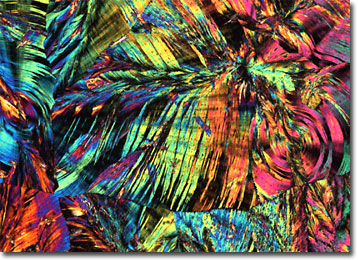Polarized Light Microscopy Digital Image Gallery
Vitamin K3
First discovered in the 1930s through a series of experiments carried out by Henrik Dam, vitamin K exists in many forms. The primary function of the fat-soluble compounds is to assist in the normal clotting of the blood, a finding also discovered by Dam.

Vitamin K1 and K2 are the naturally occurring types of vitamin K. The former, which is also known as phylloquinone, is synthesized by plants and can be found in such foods as spinach, broccoli, lettuce, and soybeans. The latter, sometimes alternatively referred to as menaquinone, is primarily produced by bacteria in the anterior part of the gut and the intestines. Vitamin K3, on the other hand, is one of the many manmade versions of vitamin K. Also called menadione, this yellowish, synthetic crystalline substance is converted into the active form of the K2 vitamin inside of the animal body.
While a vitamin K deficiency can be dangerous, especially to infants that may easily suffer from extensive hemorrhaging, an overdose can be as equally detrimental. Newborns that are administered too great a dosage of vitamin K3 can suffer from kernicterus, a form of severe brain damage that may produce decreased movement, loss of appetite, seizures, deafness, mental retardation, and even death. This condition is associated with an abnormally high concentration of bilirubin, a bile pigment, in the tissues of the brain, which can be caused by the presence of K3. For this reason, K3 is less often utilized medically than it was in former times.
